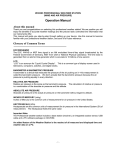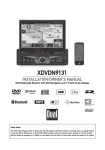Download Gogo Inflight XDVDN9131 User's Manual
Transcript
Contents -1- 01. Basic Screen a) Getting started. Initial Screen. < Declaration screen > After Gogo starts, you will see the declaration screen as shown above. < Map screen features – Normal mode> The navigation system automatically locates your current position on the map by receiving GPS signals. If the navigation system doesn’t receive GPS signals properly, it could take some time to locate your current position. Please refer to page 39 <Information> numbers 4 through 9 for GPS signal disturbance. -2- 01. Basic Screen b) Map screen features – Driving Guidance Mode The screen image below shows the map screen features when in guidance mode. Descriptions of each item are as follows: <Map screen features> 1 Zoom out: Zooming out from level 1 to level 21 Compass: By tapping this icon, you can change the map display mode 2 To Track up, North up or 3D view. (Refer to Settings>Map View for more information) 3 Next street name 4 Zoom in: Zooming in from level 1 to level 21 5 Current street name 6 7 8 Turn-by-Turn instruction: Indicates next guidance information (Tap this icon to go to Turn-by-Turn screen) GPS signal reception: Tap this icon to go to GPS Status/information page Current speed -3- 01. Basic Screen 9 Current time 10 Expected time to arrival at destination 11 Remaining travel time from current position to destination 12 Remaining travel distance from current position to destination (To go to Route Summary page, tap anywhere from 9-12) 13 Menu button: Tap to go to Menu 14 Map scale: Indicates current map scale level 15 Voice guidance repeat button: Repeats the last voice instruction -4- 02. Menu 02. Menu The main menu can be accessed by pressing the ‘Menu’ button on the map screen. Descriptions of each button are as follows. 01) [Where to?] Search for a location in various ways. 02) [My Route] Editing the current route or retrieving the current route information. 03) [Clear route] Remove all existing locations from route. 04) [Settings] Customizing settings of the navigation system. -5- 03. Main Function a) Where to? The following ‘Where to?’ screen is accessed by pressing the ‘Where to?’ button on the <Menu> screen. Users can easily search for a location in different ways according to their purpose or preference. 01) [Go home] Searching for your home location saved on your favorites list. 02) [Favorites] Searching for locations saved to your ‘Favorites’. 03) [Emergency] In case of emergency, quickly search the nearest point of interest from your current position without any complicated searching procedures. 04) [Recent Destination] Presents a list of recently searched destinations. 05) [Itinerary] Create or edit itineraries. 06) [Address] Searching for addresses. 07) [Intersections] Searching for intersections. 08) [▶] Go to page 2. -6- 03. Main Function 09) [Zip Code] Searching for locations by zip code. 10) [Point on Map] Searching for locations by pointing on the map. 11) [Cities] Searching for locations by city name. 12) [POI Category] Searching for POI around your current position. 13) [POI Name] Searching for locations by POI (Point Of Interest) name. 14) [POI In City] Searching for a POI in a certain city. 15) [POI Telephone No.] Searching for locations by telephone no. 16) [▶] Back to page 1. -7- 03. Main Function Home This function allows you to quickly navigate to your home. You can also search for your home location via ‘Favorites’. Select ‘Go Home’ on [Where to?] screen. This [Go Home] button will be activated if you registered your home location via [Add to favorites] explained on page 9 or [Settings]>[Home]. Only one place can be registered as the home location. You can change your home location via [Settings]>[Home] and also delete it via [Settings]>[Manage Favorites]. -8- 03. Main Function Favorites This function allows you to save addresses or Points of Interest (POI) that you frequently visit; for example, you may want to save your work address or friend’s address so that you can quickly and easily navigate to it. 1. Select ‘Favorites’ on [Where to?] screen. 2. Press the button to add a location to your favorite list. 3. To navigate to a favorite, simply tap on the favorite name. Select to order existing favorites alphabetically. Select to order existing favorites by the date / time of when you created the favorite entry. 4. Select the manage button, favorites. 5. Press the rename 6. Press the delete to edit, rename or delete your button to rename a favorite. button to delete a favorite. The [Home] favorite also appears in the favorite list. You can edit, change or delete the [HOME] location via [Menu]>[Settings]>[HOME]. -9- 03. Main Function Emergency In case of an emergency, quickly search the nearest emergency point of interest (e.g. hospital) from your current position without any complicated searching procedures. It will then find a route and start guidance automatically. Recent Destination Searching for recent destinations. (Automatically saves up to ten destinations.) 1. Select ‘Recent Destination’ on [Where to?] screen. 2. It will list recent destinations. 3. Select one of locations on the list then tap ‘Next’ button. For sorting by name tap -10- . For sorting by time tap . 03. Main Function Address Searching for a location by using address. <City Search> <State/Province Search> <Street Search> <House number. Search> 1. Select ‘Address’ on [Where to?] screen. 2. For your convenience, previously searched state/province name and city name are initially selected on the first stage of address search. If you want to change state/province, tap [Change] button. For State/Province search, you can search by either the full name (e.g. New York), or abbreviation (e.g. NY). 3. Search for a city name by typing letters. Then choose it on the result list. (Only valid next letters appear.) 4. Search for a street name by typing letters then choose it on the result list. 5. Reconfirm your state/province, city, and street choices on the top of <House number. Search> page, then type the House no. and tap 'Done' button. -11- 03. Main Function (Instead of searching [House No.], searching by intersection is also possible. Tap this intersection image button , then it will list intersections of the selected street. Select one on the result list, then tap 'Done' button.) Intersections Searching for a location by using intersection. 1. Take the searching steps [STATES]-[CITY]-[STREET], then it will list intersections of selected street. Select one on the result list, then tap 'Done' button. (Refer to image screens on page 11 for searching steps.) POI Telephone No. Searching for a point of interest location by using Telephone No. 1. Select ‘Telephone No.’ on [Where to?] screen. 2. Search telephone number by typing numbers. 3. Tap one on the list that you are looking for, then it will list address information corresponding to the selected telephone number. Select one on the result list, then tap 'Done' button to proceed. -12- 03. Main Function Zip Code Search for a location by using zip code. 1. Select ‘Zip Code’ on [Where to?] screen. 2. After searching zip code, proceed to the next searching steps [Street][House no.] or [Intersection]. (Refer to address search on page 10.) Point on Map Searching for a location by pointing on the map. 1) Tap: Tap anywhere on the map and you will see the street address. Press the done button to set this location as your destination or via point. 2) Pan: Press and drag the map to pan in any direction. 3) Find a POI nearby the chosen point on map by tapping find POI button. -13- 03. Main Function ‘Point on Map’ may be accessed at any time simply by tapping on the main map window. To change the labeling option on the map, tap the button . You can turn on and off three map labeling options: ‘Street Name’, ‘POI Symbol & Name’, and ‘Favorites Symbol & Name’. Refer to [Settings]-[Label On Map] on page 28 for more information. Itinerary In this page, you can plan the details of your itinerary. For convenience sake, you can save your itinerary so that you can easily start traveling without any searching steps next time. <Current Itinerary (Initially empty)> <Itinerary name> -14- <Itinerary Options> <Current Itinerary (Recently planned)> 03. Main Function 1. The initial itinerary page is empty. To plan a new itinerary, tap . 2. Select [New] button, then enter a name for a new itinerary. Tap 'Done' button. • Start Navigation: Start traveling. • New: Create a new itinerary. • Rename: Rename the current itinerary. • Load: Load one of itineraries. • Delete: Delete one of itineraries. 3. To add a location to your itinerary as departure, via point, or destination, tap . If you select a location on the list, it will present six options for editing the selected location. • Destination: Set a selected location as destination. • Visited: Setting a selected location as a visited location tells the navigation system that you’ve already visited this location, so skip this location when routing. Re-applying this function to a visited location will cancel the visitation of it. (This function will be deactivated if the selected location is a destination or departure.) • Show On Map: This function will take you to the selected location on the map. • Delete: Delete a selected location. • Move up: Move up a selected location in the itinerary. • Move down: Move down a selected location in the itinerary. -15- 03. Main Function Cities Search for the center of city. After taking searching steps [STATE]-[CITY], press [Done] when ready. Refer to [STATE]-[CITY] searching steps on page 11. POI Name Searching for a location by using POI name. 1. Select ‘POI Name’ on the [Where to?] screen. 2. The previously searched state/province name and city name are initially selected. If you want to change state/province or city, tap […] button. Type POI Name then tap ‘next’ button. It will list valid POI names corresponding to the letters you’ve typed. Select one of the POI names that you’re looking for, then it will list all valid locations with address information. Choose one and then tap ‘next’ button. (When typing, only next available letters appear.) 3. Press [Done] when ready. -16- 03. Main Function POI In City Searching for a POI in a particular city. 1. [POI Category] screen (left screen image) is shown when you finish [State/Prov]-[City] searching steps. The 28 POI categories are arranged in the order of frequency of driver’s use. (Refer to ‘Address’ search on page 11 for [State/Prov]-[City] search.) 2. Select one of POI categories, then it will list POIs in order of distance from current position. Tap to order alphabetically, or tap to order by distance. Select one POI, then tap next button. Some POI categories have sub menus; for example, the Food POI category contains a sub menu for various cuisine types. POI In Category Searching for POI around the current position. Since this searching is based on your current position, there is no area selection steps ([State/Prov]-[City]). Other searching steps are the same as POI In City. -17- 03. Main Function Start Traveling Guidance To start guidance, you should tap the start button on the [Route Summary] page. The above screen image is the captured image when traveling guidance has begun. (Refer to <Map screen features – Traveling guidance mode> on page 3 for an explanation of map features.) Turn by Turn The Turn by Turn Screen offers a more simplified guidance mode. To access this screen, simply tap the bottom-right maneuver picture on the main map screen, or, go to [Menu] > [My Route] > [Turn by Turn]. The Turn By Turn mode presents a enlarged maneuver image and text to indicate the next turn. The distance remaining to the next maneuver is indicated by the distance bar on the right. The second maneuver is displayed at the top of the screen with a smaller image and text. -18- 03. Main Function < Turn List > The Turn List presents a full list of all maneuvers for the journey. This screen may be accessed by pressing the List button in the Turn by Turn mode. The default setting of this option is ‘Distance from position’. If you want to change this option, tap ‘Options’ button at the bottom of screen. • Distance since departure Shows distance from departure to each turning point. • Distance to instruction Shows distance from previous turning point to next turning point. • Distance from position Shows distance from current position to each turning point. • Time since departure Shows required time from departure to each turning point. • Time to instruction Shows required time from previous turning point to next turning point. • Time from position Shows required time from current position to each turning point. • Time of day Shows expected time when arrived at each turning point. -19- 03. Main Function Turning off device before journey is complete. In case of unexpected shutdown during the journey, the navigation system will remind you of the last destination when restarted. If you want to restore your previous route, select 'Done' button. Otherwise select ‘Cancel’ button. In addition to this, any VIA point that was unreached in the journey will be remembered. By going to [Menu] > [My Route], you can check via and destination points. -20- 03. Main Function b) Route Options Manage your route Routing Options may be used to create a new route or to edit an existing route. Create Route / Edit Route buttons will change depending on situation. • Create Route / Edit Route [Create Route] is available if a route has not been set. [Edit Route] is available if a route has already been set. Use this option to edit your existing route. • Detour Allows you to avoid part of the route, a roadblock, or to set a travel Via point. • Simulation Mode Starts a driving simulation of the route. • Route Summary Go to the route summary page. • Map Mode Displays a full map of your route. •Turn by Turn Displays a simplified guidance mode with no map. -21- 03. Main Function Create Route This function is available if no route has been set. • Add a Location to your route Press the ADD button to add a location to your route. For short routes, you may add up to 20 Via Points . The number of Via Points may be less for longer routes. • Position the location within the route The first location you set automatically becomes the destination. You may add another location to this route by pressing the ADD button. Additional locations added become either Departure points, Via Points or Destination points depending on their respective position within the route list. You may rearrange your route simply by selecting the location and choosing to move up, down in the list. Save Route Press the save button to save your route. This route may be accessed at a later stage via the Itinerary menu Where to > Itinerary Calculate Route When finished, press the DONE button to calculate the route. -22- 03. Main Function Edit Route This function is available if a route already exists. • Add a Location to your route Press the ADD button to add another location to your route. • Position the location within the route The first location you set automatically becomes the destination. You may add another location to this route by pressing the ADD button. Additional locations added become either Departure points, Via Points or Destination points depending on their respective position within the route list. You may rearrange your route simply by selecting the location and choosing to move the location up or down in the list. • Find POI nearby any location Simply select the location and choose ‘Find Nearby POI’. After selecting the POI, it will be added to your route. • Save Route Press the save button to save your route. This route may be accessed at a later stage via the Itinerary menu: [Where to] > [Itinerary] • Calculate Route When finished modifying the route, press the DONE button to calculate. -23- 03. Main Function Detour This function is for editing your route. After editing your route preferences, the navigation system will recalculate a new route automatically. <Detour Menu> <Avoid Roadblock> <Avoid Part of Route> <Travel via> You can change your route via four functions as follows: • Avoid part of route Make a detour to avoid some part of existing route. • Avoid roadblock Make a detour to avoid a roadblock. You can set 100ft, 300ft, 500ft, 1mi, 2mi, or 3mi as a length of roadblock. For example, if you are stuck in traffic because of a construction site or a car accident ahead of you, you can apply the relevant distance to roadblock, and the navigation system will make a detour to avoid that roadblock. -24- 03. Main Function • Travel Via Add a via point to your route. This will bring you into the normal [Where to] screen. Choose from any of the available methods to find a location to add to your route. • Recalculate Original This button allow you to recalculate the original route by removing any detours or others changes that may have been set. -25- 03. Main Function Route Summary Page If your decision on [Route Decision] page created a route and [Settings][Routing Options]-[Show ‘Route Summary’ page automatically] option in setting is enabled, the [Route Summary] page will show up. In this page, you can check route information such as total distance, time, etc. It’s also possible to reroute via three options as follows. • Faster Time Reroute considering faster time. • Shorter Distance Reroute considering shorter distance. • Avoidances Reroute with road avoidance options such as U-Turns, Toll Roads, Carpool Lanes, and others. <Fuel cost> represents an estimated cost for your trip. Fuel prices and fuel consumption for your vehicle may be adjusted by going to [Menu] > [Settings] > [Fuel Cost] -26- 04. Settings 04) Settings In this page, you can customize the settings of the Navigation system. Descriptions of each option are as follows: 01. [Color Mode] You can set the color mode of map as ‘Daytime’, ‘Nighttime’, or ‘Auto mode’. Auto mode will allow the navigation system to automatically choose day or night mode based on the current system time. 02. [Map View] You can change the view mode of map as ‘Track up’, ‘North up’, or ‘3D View’ mode. 03. [Set Brightness] You can adjust the map brightness of day/night. 04. [Map Colors] You can change the map color. 05. [Auto Zoom] You can set the automatic zooming at intersection or on speed. 06. [Home] You can register or change your home location. -27- 04. Settings 08. [Label on Map] You can turn on/off displaying some labels on map. 09. [Voice/Text Language] You can change voice/text language of Navigation. 10. [Routing Options] Changing routing options. 11. [Units] Change distance units (miles or meters) 12. [Set Clock] Setting your navigation time and apply some options such as ‘Daylight saving’ and ‘Sync. with GPS time’. 13. [Time Zone] Select time zone. 14. [Speed Limit] Turn on/off the speed warning. Set a tolerance level for receiving a warning alert; for example, set tolerance level as 2mph to receive a warning when you exceed the speed limit by 2mph. 15. [Fuel Cost] Adjust fuel prices and consumption. 16. [Volume] You can turn up/down the volume and link the volume to car speed 17. [Keyboard] Changing Keyboard Option 18. [About] Shows product name and version. 19. [Restore Settings] Restore all settings to factory defaults. -28- 04. Settings Color Mode Change the color mode of map as ‘Daytime’, ‘Nighttime’, or ‘Auto’ mode. • Daytime: Daytime color mode. • Nighttime: Nighttime color mode. (Refer to the right side image.) • Auto: Automatically change the map color by time. Map View • Track up: The direction of car is always upside of map screen. • North up: The map screen is fixed to north direction up. • 3D View: 3-dimensional ‘Track up Mode’. (Refer to the right side image.) -29- 04. Settings Set Brightness By touching the map images, adjust day or night brightness of map screen according to your preference. Then tap 'Done' button. • Day: Adjust day brightness of map screen. • Night: Adjust night brightness of map screen. Map Colors By touching the map images, change day or night color of map screen according to your preference. Then tap 'Done' button. • Day Color: Select day color of map screen. • Night Color: Select night color of map screen. A darker map color is used to reduce glare and eye strain while driving. Auto Zoom You can turn on/off automatic zooming at the intersection and automatic zooming on speed options. • At the Intersection: Automatically zoom in/out to a certain map scale level at the next maneuver intersection. • On Speed: Automatically adjust map scale level according to the speed of car. (Speed up->Zoom out, Speed down>Zoom in) -30- 04. Settings Home Register or change your home location. Label on Map Show/hide some labeling options on the map screen. Select options that you wish to be displayed on the map screen, then tap the 'Done' button to apply these settings on the map screen. Street Name POI Symbol & Name Pressing this button will allow you to hide or display POIs based on category type. You can choose to only display your favorite POI types, for example Food, Fuel, Lodging etc Favorites Symbol & Name: symbols and names of registered place as your favorite. -31- 04. Settings Voice / Text Language Change voice / text language option. • Voice Language: Gogo offers three voice languages (English, Spanish and French), and each language has a male/female voice. And if you want to hear the sample voice of the selected one, tap . To apply the selected voice language, tap 'Done' button. • Text Language: Three text languages are also supported. Routing Options Set routing options. • To route considering faster time, select ‘Faster Time’ option. To route considering shorter distance, select ‘Shorter Distance’ option. To route avoiding with some options, go to ‘Avoidance Options’ page by selecting ‘Avoidances’. Choose avoidance options that you wish to avoid, then tap the 'Done' button. • Show ‘Route Summary’ Page automatically: If this option is checked, the ‘Route Summary’ page will be shown whenever the routing planning is complete. Otherwise, it will start guidance immediately. -32- 04. Settings Units Set distance units. You can choose one of following two options. • Miles/Feet • Kilometers/Meters Set Clock Set time manually. • Sync with GPS: Synchronize the time on your device with GPS time. • Daylight Saving: Apply daylight saving. Time Zone Set time zone. • Select one of 30 time zones. The default time zone is US-Pacific. -33- 04. Settings Speed Limit Control how speed limit sign and warnings are given. The map data contains speed limit information for some, but not all roads. This information exists generally for highways and other major roads. For your convenience, the speed limit unit; i.e. miles or kilometers, matches the system’s unit setting. Speed warning: An acoustic warning is given when the speed limit is exceeded. Speeding tolerance: The acoustic speed warning may be adjusted by using the Speeding Tolerance. For example, on a 60mph road, if the Speeding Tolerance is set at 3mph, the driver is alerted if the vehicle exceeds 63mph. Show on Map: Choose how to display the Speed Limit Sign on the main map: • Always: Speed Limit Sign will be displayed on map where available • Only when exceeding limit: Displayed only when exceeding speed limit. This control is independent of the Speeding Tolerance. • Never: Speed Limit Sign is never displayed on the main map The Speed Limit Sign displays miles or kilometers according to the system’s unit settings. This may be changed by going to [Menu] > [Settings] > [Units]. -34- 04. Settings Fuel Set current fuel price, and adjust consumption estimates according to vehicle. Your journey’s fuel cost estimate will appear on the ‘Route Summary’ page. You can access this screen via [Menu] > [My Route] > [Route Summary]. • Fuel Price Fuel prices fluctuate throughout the year. This setting allows you to adjust the fuel prices according to current prices. Currency options include Dollar ($), Euro (€), British Pound (₤), Swiss Franc (₣), and Danish Krone (kr). Pricing for fuel volumes can be set as either ‘per gallon (US)’ or ‘per liter’. • Consumption The consumption section allows you to set your vehicle’s fuel consumption. This fuel consumption will then be used in the cost estimate for your trip. Most modern vehicles include a fuel economy label which describes the vehicle’s fuel economy ratings. Alternatively, to find out your vehicle’s fuel consumption, please see the ‘Fuel Economy Guide’ at www.fueleconomy.gov. This guide is published by the U.S. Environmental Protection Agency (EPA) and U.S. Department of Energy (DOE). It contains an extensive listing of most vehicle makes and models. Vehicle consumption is typically expressed as two fuel economy estimates: • City: represents urban driving and driving in stop and-go rush hour traffic. City driving typically consumes more fuel than highway driving. • Highway: represents driving on a mixture of rural and interstate highway driving, typical of longer trips in free-flowing traffic. • Note Please be aware that the actual fuel cost may vary according to other factors which affect the fuel consumption; for example, driver behavior, driving conditions, vehicle maintenance, fuel characteristics, and weather. The cost estimate is an estimate of fuel costs only. Other costs, such as Toll charges are not included in the calculation. -35- 04. Settings Volume Set volume. Volume setting to control voice guidance. Pressing the minus <–> or plus <+> button will sound a chime to indicates the volume level. • Link volume to car speed: <Link volume to car speed> increases or decreases the volume to compensate for road noise; for example, the volume will automatically get louder when you drive faster, and conversely, it will return to normal volume level for moderate driving speeds. Keyboard Set Keyboard option You can select your keyboard layout preference here. This will change the keyboard layout for address and POI searches among others. • ABCD • QWERTY • AZERTY About Shows the product name, version, data source and other licensing information. • Product Key identifies your product. You will need this key when contacting customer service. -36- 04. Settings Restore Settings Restore all settings to factory defaults. Note Please use caution when choosing this option, as any adjustments you have made to settings will be lost! -37- 05. GPS 05) GPS You can check GPS status and GPS information on this page. • Blue satellite: GPS fix is established. • Pink satellite: GPS fix is unavailable. Pressing the <Reset> button will reset the GPS module. It may take up to one minute to reacquire the GPS signal It may take some time to receive GPS signals. Please refer to page 39 <Information> for GPS signal disturbance. -38- 06. Information User information and precautions 1. We are not responsible for any accident that occurs while operating our software. 2. The suggested route and guidance may be different with actual traffic and road conditions. Please drive safely and obey traffic rules. 3. Map screen images and user interface information printed on this manual may not correspond with actual device due to additional features or any modifications. Display colors printed on this manual may appear different with the actual screen color of device in result of manufacture process and printing ink. EnGIS does not warrant that this document is error-free. 4. To prevent GPS signal disturbance, please make sure that you are outside and the GPS antenna has a good visibility of the open sky. 5. If you are in the downtown area where buildings are crowded densely, it may cause the GPS signal reception disturbance. It’s not possible to receive GPS signals in a tunnel, underground parking lot, or enclosed space. 6. Do not place any object near GPS antenna that will cause GPS signal reception disturbance. 7. Some specially coated windshields, such as a heat-reflecting windshields, may block the GPS signal reception inside the vehicle. 8. Do not install electronic equipment with strongly emitting electromagnetic waves such as a radio wave transmitter near the GPS antenna. 9. The rate of GPS signal reception may be low due to the weather and atmospheric conditions. 10. To prevent data loss, please quit the program before mounting or releasing your device. 11. Do not operate your device while driving. Please drive safely and pay attention to the surrounding traffic and pedestrians. Always observe safe driving practices. -39- Information 12. This product is designed as an aid to safer driving. You may receive speed alerts to help you monitor your speed. EnGIS accepts no liability whatsoever for you receiving any speeding fines or points on your license through using this software. EnGIS does not guarantee the accuracy of the data contained within this database either expressed or implied. 13. Information in this document is subject to change without notice. EnGIS Technologies, Inc. reserves the right to make changes to the navigation application or make amendments to the content of this document without obligation to inform any organization or user of such changes. Please visit the Gogo website, www.gogonav.com, for the latest version. -40- Copyright Copyright 1. Copyright and intellectual property rights of all documents written by EnGIS Technologies, Inc. are the property of EnGIS Technologies, Inc. 2. EnGIS Technologies, Inc. has copyright and intellectual property rights of our software and documents including this manual, and the use of product follows license agreement. Product warranty and liability limit are included in license, and more specific subjects can be arranged by a discussion with a staff member in charge. 3. “Gogo“ is EnGIS Technologies, Inc. own brand and is a registered trademark. 4. All names are trademarks or registered trademarks of their respective owners. You cannot infringe ownership without permission. 5. The following contents stated on (A) are EnGIS Technologies, Inc. own technology and property. You cannot use or let a third party use all or any parts of this technology or property for any commercial purpose in any way copying, transmitting, publishing, saving on recovery system, translating into other languages (publishing), distributing, or broadcasting without the express written permission from EnGIS Technologies, Inc. (A) 1. Our navigation software 2. Manual contents 3. All symbols and icons related our Navigation 4. All designs (screen composition, screen arrangement, screen color, screen design) related to our Navigation. Data sources: ©2009 Tele Atlas. All rights reserved. Tele Atlas and the Tele Atlas logo are registered trademarks of Tele Atlas B.V. Software Components Loquendo Text-To-Speech (TTS) Synthesis Software Copyright ©2009 , Loquendo S.p.A. Visit http://www.loquendo.com for the official web site. Official copyright notice and specific license conditions can be found in the license folder of the navigation product. Other Data Sources and Software Components Other Data sources and Software components are listed in the ‘About ‘page of the navigation application. Go to Menu > Settings > About. -41- Information More information If you have any problems or any difficulties with our software, please refer to the FAQ section on our website, or register your question on the Q&A section. We will supply support as soon as possible. Website: Email: www.gogonav.com [email protected] Map Update Please visit www.gogonav.com for map updates. -42-






















































